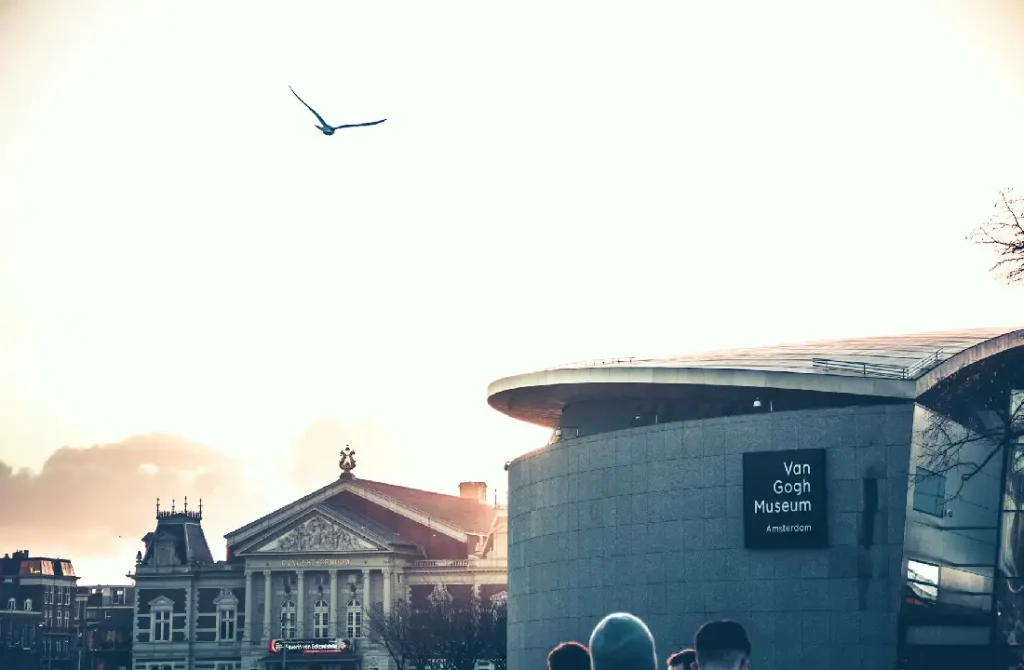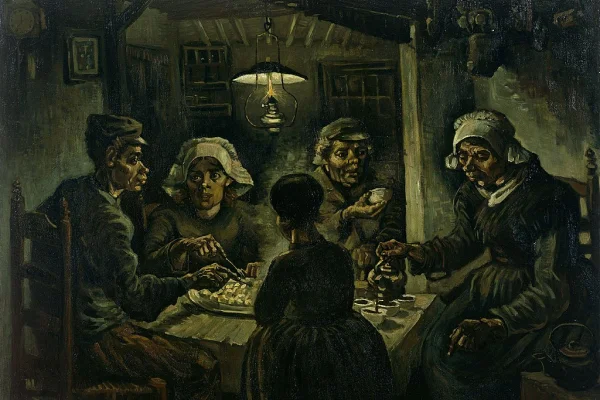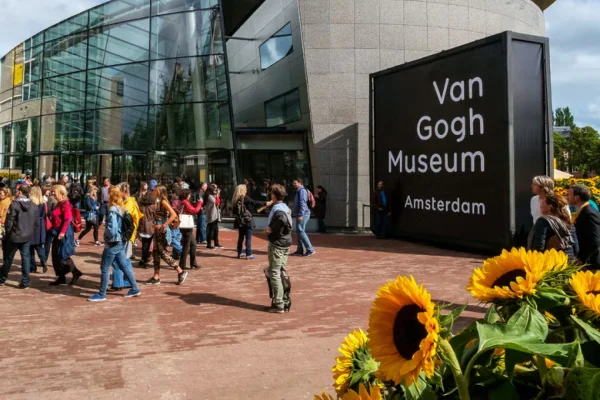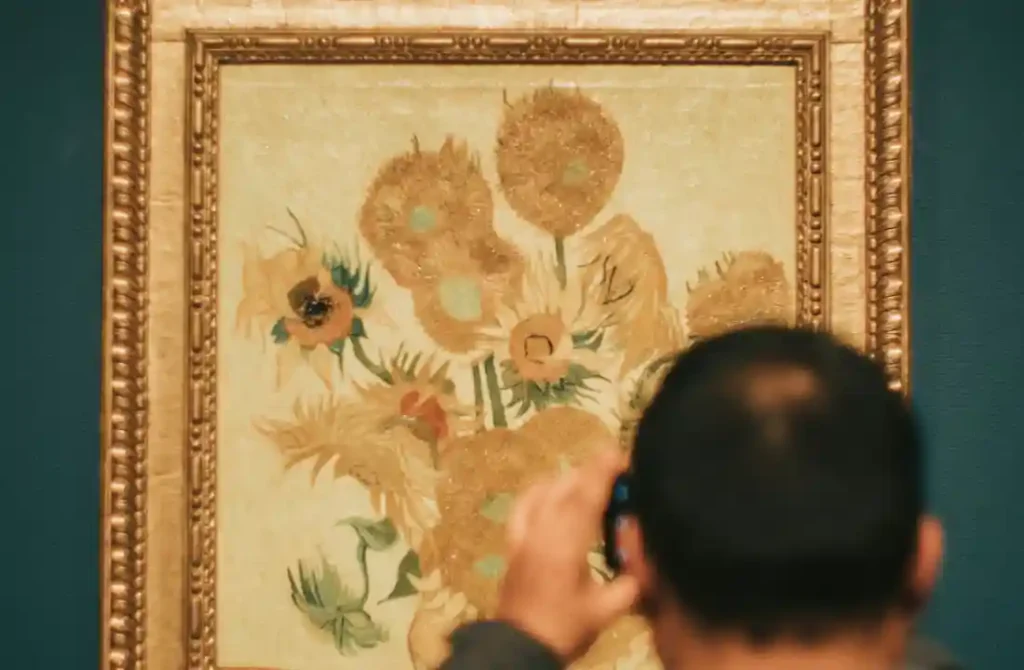Vincent van Gogh’s ‘The Potato Eaters’ (1885) depicts a poignant family scene with raw emotion and earthy tones, capturing the struggles of rural life.
The details provided cover the essential aspects of The Potato Eaters, but adding a bit more context and information can give a fuller understanding of the painting.
Artist: Vincent van Gogh
Year of Creation: 1885
Technique: Oil on canvas
Art Movement: Post-Impressionism
Time of Creation: Van Gogh worked on The Potato Eaters from late March to early April 1885, after months of preparatory sketches and studies.
Composition: The painting depicts five peasants—a family—seated around a wooden table in a dark, rustic interior, sharing a meal of potatoes. The figures have coarse, angular features and appear to be in deep conversation or prayer.
Colors: Van Gogh used a dark and earthy color palette, dominated by browns, greens, and muted yellows. The only source of light is a small oil lamp, casting a warm glow over the scene and creating strong contrasts between light and shadow.
Influences: Van Gogh was heavily influenced by the works of Jean-François Millet, a French artist known for his depictions of rural life. Van Gogh admired Millet’s ability to capture the dignity and hardship of peasant life and sought to do the same with The Potato Eaters. Additionally, Van Gogh’s earlier studies of peasant life in Nuenen and his admiration for the Dutch Masters, particularly Rembrandt’s use of light and shadow, informed the composition and execution of this work.
Context in Van Gogh’s Career: The Potato Eaters is often considered one of Van Gogh’s first major works. It marks a significant moment in his development as an artist, showcasing his deep commitment to realism and his interest in depicting the lives of ordinary people.
Symbolism and Themes: The painting is rich in symbolism. The dark, earthy tones reflect the hard, laborious life of the peasants, while the act of sharing a simple meal of potatoes symbolizes their humble existence and the solidarity of rural life. The rugged, almost caricature-like depiction of the figures emphasizes their connection to the land and their toil.
Critical Reception: At the time of its creation, The Potato Eaters was not widely appreciated and even received some criticism for its unconventional style and rough execution. However, it is now considered a masterpiece and a key work in understanding Van Gogh’s artistic journey.
Location: The original painting is housed in the Van Gogh Museum in Amsterdam, which is dedicated to the life and work of the artist.
Preparatory Works: Van Gogh created numerous sketches and studies in preparation for The Potato Eaters. These preparatory works reveal his meticulous approach to capturing the scene, focusing on the arrangement of the figures and the interplay of light and shadow.
Influence on Later Works: While The Potato Eaters is quite different from Van Gogh’s later, more colorful works, it laid the foundation for his exploration of human emotion, expression, and his evolving use of color and brushwork. Visit the Van Gogh museum exhibition to see ‘The Potato Eaters’ and explore Van Gogh’s powerful portrayal of rural life and intimate family scenes

The Potato Eaters is one of Vincent van Gogh’s most significant early works, completed in April 1885 during his time in Nuenen, a small village in the Netherlands. This painting is often regarded as a pivotal piece in Van Gogh’s career, showcasing his evolving style and his deep commitment to portraying the lives of the rural poor with raw honesty and empathy. The story behind The Potato Eaters is a fascinating one, filled with Van Gogh’s passion, struggle, and determination to create something meaningful.
By the time Van Gogh painted The Potato Eaters, he had already endured years of personal and professional struggles. His journey to becoming an artist was not straightforward. After abandoning careers in teaching, theology, and working as an art dealer, Van Gogh decided to pursue his passion for art seriously in his late twenties. He was largely self-taught, and his early works focused on drawing and painting peasants and workers, reflecting his deep concern for social justice and his admiration for the simple, hard-working lives of rural people.
Van Gogh’s admiration for the peasantry was heavily influenced by the works of artists like Jean-François Millet, who depicted rural life with dignity and respect. Van Gogh believed that the life of the peasant was one of both hardship and nobility, and he sought to convey this duality in his art. His early work in Nuenen, where he lived with his parents from 1883 to 1885, was dominated by studies of the local villagers, their daily lives, and the harsh conditions they endured.
The Potato Eaters was the culmination of months of preparation, during which Van Gogh produced numerous sketches and studies of the local peasants. He was determined to create a work that was not only visually striking but also authentic in its depiction of peasant life. Van Gogh believed that the key to capturing the essence of his subjects lay in portraying their connection to the land and their sense of community.
The painting depicts five figures—a family of peasants—seated around a table in a dimly lit room, sharing a meal of potatoes. The earthy tones and rough, angular forms of the figures create a sense of austerity and realism. Van Gogh deliberately chose to depict the peasants with coarse features and darkened skin, emphasizing their hard lives and the physical toll of their labor. The lighting in the painting is particularly noteworthy, as it creates a somber and intimate atmosphere, with the single oil lamp casting a warm, golden glow over the scene.
Van Gogh’s use of light and shadow in The Potato Eaters reveals his growing mastery of these elements, which he would continue to develop throughout his career. The faces of the peasants are illuminated in a way that highlights their expressions and gestures, bringing a sense of life and movement to the scene. The central act of sharing a meal underscores the theme of community and the peasants’ connection to the land—they eat the very potatoes they have cultivated with their own hands.
Despite Van Gogh’s belief that The Potato Eaters was one of his best works, the painting was not well received by critics or fellow artists at the time. Some criticized the composition and the figures’ exaggerated features, while others found the dark palette unappealing. However, Van Gogh remained proud of the work, viewing it as a true representation of peasant life and a testament to his commitment to depicting the reality of the human condition.
Over time, The Potato Eaters has come to be recognized as a masterpiece and a crucial work in Van Gogh’s oeuvre. It represents a key moment in his artistic development, where he transitioned from the more traditional styles he had been practicing to the unique and expressive approach that would later define his work. The painting also reflects Van Gogh’s deep empathy for the working poor, a theme that would continue to resonate throughout his career.
The Potato Eaters is more than just a depiction of a simple meal; it is a powerful statement about human dignity, community, and the harsh realities of rural life. Van Gogh’s dedication to capturing these themes, despite the initial lack of recognition, speaks to his unwavering commitment to his artistic vision. Today, The Potato Eaters stands as a testament to Van Gogh’s early struggles and his profound connection to the lives of the people he sought to portray.

The Potato Eaters remains one of Van Gogh’s most significant works. Painted in 1885, it was an ambitious project that he considered one of his masterpieces. Despite receiving criticism during his lifetime for its dark tones and unconventional composition, the painting is now highly regarded for its raw depiction of peasant life and Van Gogh’s dedication to portraying the dignity of the working class.
Yes, The Potato Eaters is considered a masterpiece, although it was not universally appreciated during Van Gogh’s life. It represents a key moment in his development as an artist, demonstrating his commitment to realism and his empathy for the rural poor. The painting’s powerful, somber mood and its portrayal of the harshness of peasant life have earned it a place among Van Gogh’s most important works.
The original The Potato Eaters is housed at the Van Gogh Museum in Amsterdam, Netherlands. This museum holds the largest collection of Van Gogh’s works, and The Potato Eaters is one of its most significant pieces.
The Starry Night is often interpreted as a reflection of Van Gogh’s emotional state, possibly representing his feelings of isolation and longing for connection. The swirling night sky and the contrasting calm village below suggest a sense of turbulence and peace coexisting. Some art historians also believe that it reflects Van Gogh’s interest in astronomy, as the stars are depicted with unusual intensity and clarity.
The Potato Eaters reflects Van Gogh’s deep empathy for the working-class peasants and their difficult lives. He wanted to portray them with honesty and dignity, focusing on their connection to the earth and the simplicity of their existence. The dim lighting, earthy tones, and the act of sharing a meal highlight their bond with one another and their humble, hard-earned livelihood.
Van Gogh was inspired by his admiration for peasant life and his desire to depict the reality of their existence. He was influenced by artists like Jean-François Millet, who also focused on rural and working-class themes. Van Gogh spent time observing and sketching peasants, striving to create a painting that captured the authenticity of their world, ultimately leading to the creation of The Potato Eaters.
More information about the Van Gogh Museum

VAN GOGH MUSEUM TICKETS
You can only buy tickets for the Van Gogh Museum online. Van Gogh museum ticket price is 32€. The ticket includes entry…

VAN GOGH INFORMATION
Vincent van Gogh was a renowned Dutch artist known for his striking and vibrant works, which remain highly influential in art…

VAN GOGH INFORMATION
The Sunflowers series primarily depicts a vase filled with sunflowers at different stages of life, from full bloom to wilting…
Top things to do in Amsterdam
